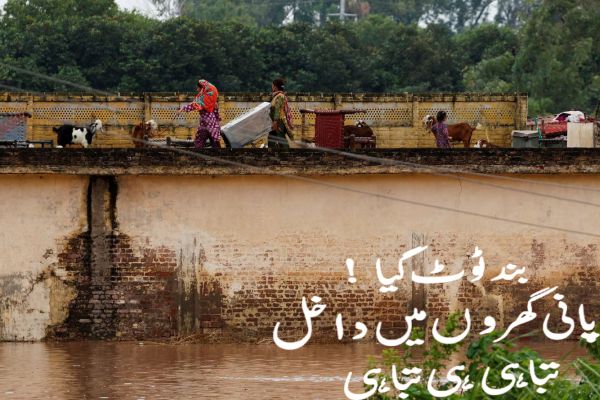ISLAMABAD:
Officials on Monday confirmed that heavy monsoon rains and dam water releases from India have intensified the threat of severe flooding in Pakistan’s eastern Punjab province. At least 33 people have lost their lives, while nearly 2 million residents have been displaced since last week.
Punjab,
Pakistan’s most populous and agriculturally vital province, is facing record-breaking monsoon downpours, worsened by surplus water flowing from India. Across Pakistan, floods and seasonal rains since June 26 have claimed 854 lives.
“All departments are on high alert as India continues to release water into the Chenab River,”
said Irfan Ali Kathia, Director General of the Provincial Disaster Management Authority (PDMA) Punjab. “We are monitoring river levels around the clock.”
Kathia confirmed that Punjab has launched the largest rescue and relief operation in its history, providing food, shelter, and essential supplies to affected families.dam
Punjab Relief Commissioner Nabeel Javed
announced the establishment of 506 relief camps and 352 medical centers across districts severely affected by the floods.
Over 17,000 people have received medical aid,
while more than 500,000 livestock have been moved to safer areas.dam
Authorities warned that water flow in the Chenab River was expected to surge from 479,000 to 700,000 cusecs by Monday evening, posing a serious threat to downstream regions.
At Panjnad, the convergence point of Punjab’s five rivers, water levels were predicted to approach one million cusecs between September 2 and 3.
Meanwhile,
Pakistan’s Commissioner for Indus Waters issued a letter citing warnings from the Indian High Commission about potentially dangerous flood levels at Harike and Ferozepur on the Sutlej River.
Under the Indus Waters Treaty, India is required to release excess water when reservoirs exceed storage capacity, but the sudden influx often triggers major floods downstream in Pakistan.dam
Climate Change Intensifies Pakistan’s Flood Threat
Pakistan ranks among the world’s most climate-vulnerable nations, facing a growing wave of extreme weather events such as heat waves, erratic rainfall, droughts, and cyclones.
Lt. Gen. Inam Haider Malik, Chairman of the National Disaster Management Authority (NDMA), declared that Pakistan is now in a state of climate emergency.
“Every two months,
the country faces a major natural disaster, and climate change is turning into a national security threat,” Malik warned, calling for urgent adaptation and mitigation measures.
This year’s flooding has revived memories of the catastrophic 2022 floods, when one-third of Pakistan was underwater, over 1,700 people were killed, 30 million displaced, and economic losses hit $35 billion.
Economic Impact: Inflation Threat Amid Crop Losses
In Karachi, new data revealed that Pakistan’s year-on-year dam consumer price inflation dropped to 3.0% in August, down from 4.1% in July. However, economists caution that flood-damaged crops in Punjab could quickly push food prices higher in the coming months.
The ongoing floods have destroyed more than 2,200 villages, killed at least 35 people, and affected over 2.3 million residents, creating fears of a spike in essential food costs if the situation worsens.
SEO Keywords: Punjab floods 2025,
Pakistan monsoon rains, India dam water release, climate emergency Pakistan, Punjab disaster management, Pakistan inflation floods, 2025 flood impact Punjab dam
ISLAMABAD: Pakistan’s economic outlook saw some relief in August as inflation slowed, but experts warn that recent floods, rising militant violence, and a resurgence of polio cases could intensify economic and humanitarian challenges in the months ahead.
August Inflation Declines but Risks Loom Ahead
The Finance Ministry last week projected August inflation in the 4.0–5.0% range, significantly lower than the double-digit inflation seen through much of last year. The ministry attributed this decline to stable macroeconomic indicators, improved manufacturing output, and stronger agricultural support programs.
However,
officials cautioned that extreme weather events,dam including the devastating floods in Punjab, threaten to derail progress in the farm sector, even as agricultural credit and fertilizer supplies have improved.
Statistics show that month-on-month consumer inflation fell by 0.6% in August, largely due to lower prices of perishable food items. Yet, economists warn that crop losses from the floods, which submerged 2,200 villages and killed 35 people in Punjab alone, could push food prices higher in the coming weeks.
Pakistan Reports New Polio Case Amid National Vaccination Drive
In health developments, Pakistan reported a new polio case from Tank district in Khyber Pakhtunkhwa (KP) on Monday, bringing the total number of cases this year to 24.
The Pakistan Polio Eradication Programme confirmed the latest case involved a 20-month-old girl. The announcement coincided with a phase-wise polio vaccination campaign launched across 99 districts nationwide.
Sindh: 8.9 million children targeted in 25 districts.
KP Province: More than 5.7 million children across 27 districts to be vaccinated.
Health officials urged parents to cooperate with vaccination teams to ensure all children under five receive oral polio drops to prevent the disease, which remains endemic only in Pakistan and Afghanistan.dam
Militant Violence Reaches Highest Level in a Decade
Security analysts warned Monday that militant attacks in Pakistan surged in August, marking the deadliest month since 2014.
143 militant attacks occurred in August — a 74% increase from July.
194 people were killed, including 73 security personnel and 62 civilians.
Security forces launched nationwide operations, killing 100 militants and arresting 31 suspects.
The northwestern KP province recorded the highest number of attacks — 106 in August alone — fueled by groups like the Tehreek-e-Taliban Pakistan (TTP).dam
Readmore PM Vehicle Policy Electric Bike and Rikshaw Scheme New Energy 2025-30
Army Helicopter Crash in Gilgit-Baltistan Kills Five
Adding to national tragedies, an Army Aviation MI-17 helicopter crashed during a training flight in Gilgit-Baltistan’s Hudor area, killing all five crew members on board.
The Inter-Services Public Relations (ISPR) confirmed that the crash was caused by a technical fault during a test landing.
The victims included:
Major Atif (Pilot-in-Command)
Major Faisal (Co-Pilot)
N/Sub Maqbool (Flight Engineer)
Hav Jahangir (Crew Chief)
Naik Amir (Crew Chief)
Emergency services rushed to the site, but the helicopter had already caught fire upon impact.
Conclusion
Pakistan is facing a convergence of crises — slowing but fragile economic recovery, flood devastation threatening food security, rising militant attacks, and health emergencies like polio.
While August inflation eased, experts warn that flood-induced crop losses, combined with security and health challenges, could intensify pressure on Pakistan’s economy in the coming months.
Pakistan inflation August 2025,
Punjab floods crop damage, Pakistan polio vaccination drive, militant attacks in Pakistan 2025, Pakistan helicopter crash Gilgit-Baltistan, Pakistan economy food inflation
All deceased are being transported to hospitals where doctors and medical staff remain on full alert,” officials confirmed.
This latest tragedy follows several similar incidents in Pakistan’s recent history:
August 2025: A government helicopter delivering flood relief supplies to the Bajaur region crashed amid bad weather conditions, killing all five people on board.
2015:
A Pakistan Army helicopter crashed in the country’s northern mountainous region, killing seven people, including the Philippine and Norwegian ambassadors.
Authorities have urged strict safety checks on all military and government aviation operations, especially during relief missions and adverse weather conditions.


